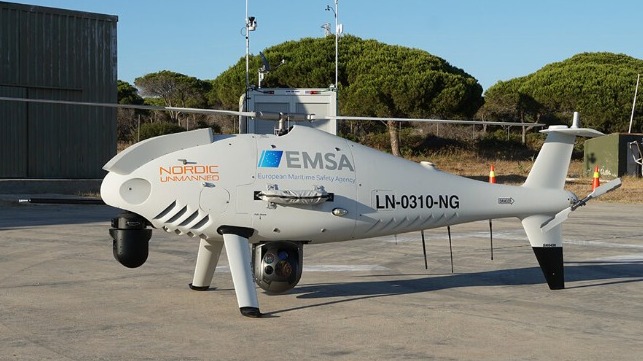Sniffer Drones Monitor Ship's Emissions in Strait of Gibraltar

The European Maritime Safety Agency is again providing the Spanish Ministry of Transport, Mobility and Urban Agenda with the capacity to monitor sulfur and nitrogen emissions of passing ships in the Strait of Gibraltar as part of its ongoing service to the EU. After first testing drones in 2017, the agency provides a variety of remotely piloted aircraft to national maritime agencies within the EU for a variety of surveillance and monitoring missions.
Spanish and international waters in the area around the Strait of Gibraltar are once again being monitored through the use of remotely piloted aircraft to check air pollution levels from emissions of nitrogen oxide and sulfur oxide released by passing ships. According to EMSA, the pollutant data gathered actively supports the monitoring of compliance with existing regulations and in doing so can help to reduce the harmful effects on human health and the environment.
The Remotely Piloted Aircraft System (RPAS) used is a Camcopter S100 unmanned helicopter which is operated by EMSA’s contractor, Nordic Unmanned. The RPAS is equipped with an emissions sensor from the contractor Explicit. This analyses the gas samples taken as the RPAS flies through the exhaust plume of the ship’s funnel. Calculations are then made to determine sulfur and nitrogen levels.
The program works in conjunction with the Spanish authorities. Indications of non-compliance are passed to local teams and can trigger an inspection at the next port of call to determine whether the vessel is in compliance with current regulations.
“This is the second emissions monitoring campaign to take place in the area, chosen for its proximity to busy shipping lanes, within the flight range of the aircraft, as well as for the expertise of the personnel monitoring maritime traffic in the area,” reports EMSA. The agency noted that the program is in advance of the recent approval of the Mediterranean as an emission control area by the International Maritime Organization. The new restrictions are expected to come into force in 2025.
EMSA has been providing drones with this “sniffer” capability for the past few years. Similar programs have also been conducted in Northern Europe with drones flying from France and Denmark. EMSA notes that Emissions monitoring is one among several purposes for which the aircraft can be deployed within the area of operation.
Other tasks for the remote aircraft can include pollution detection, suppression of trafficking and smuggling operations, fisheries control, and vessel traffic management. While the primary purpose of this new deployment is the emissions monitor in the Strait of Gibraltar, EMSA notes that the flights can also be directed to support the Spanish Maritime Safety Agency (SASEMAR) during search and rescue operations.
